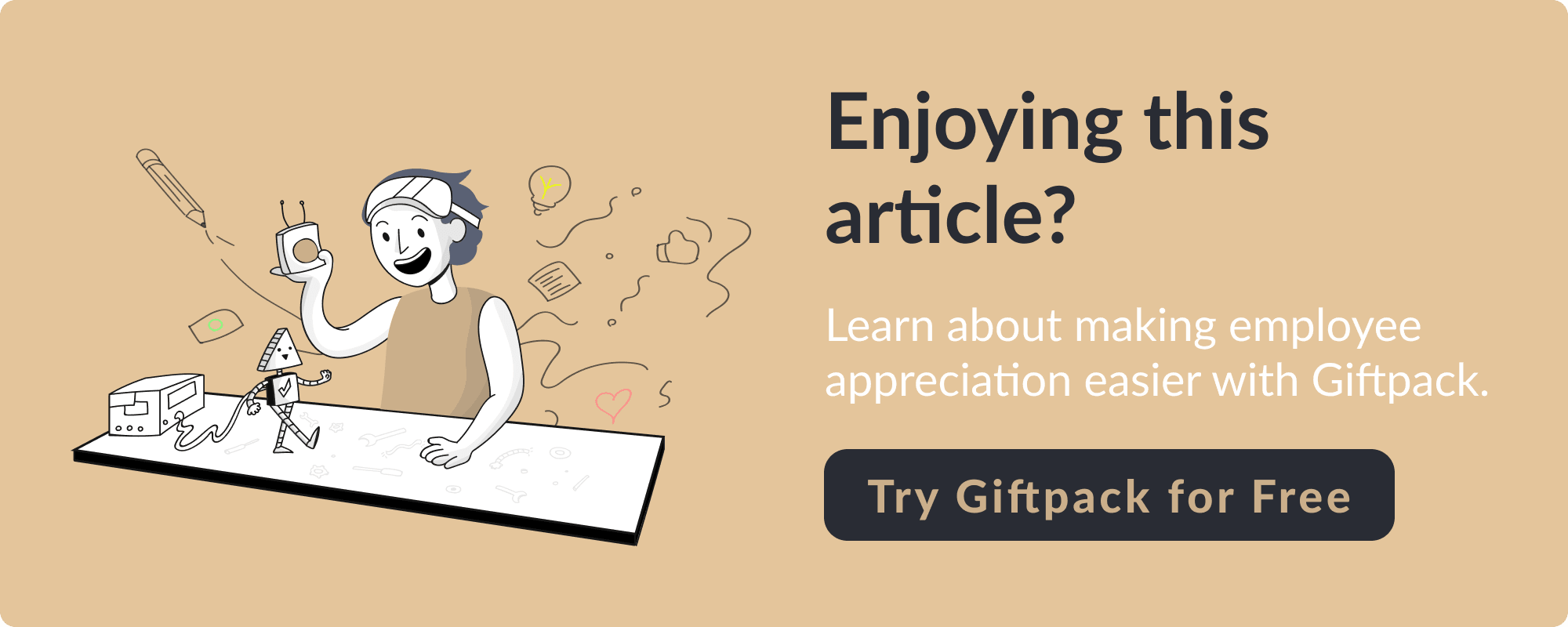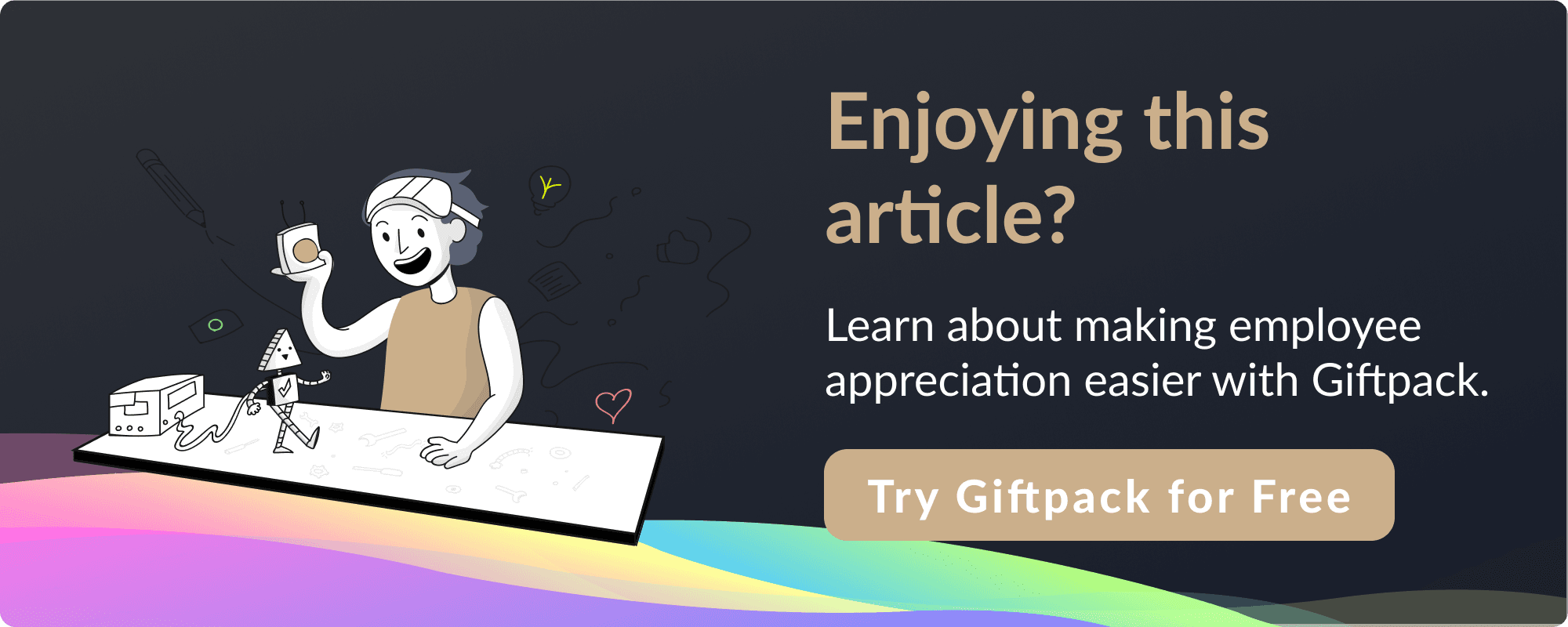
New Employee First Week Schedule Template to Ensure a Great First Week Starting a new job is a mix of excitement and nerves. Inclusive onboarding is key imagine walking into your first day, unsure of what to expect, only to be met with a whirlwind of new faces and tasks. Without a roadmap, it's easy to feel lost. That's why a well-structured New Employee First Week Schedule Template is crucial. It sets the tone for a smooth transition, helping new hires feel comfortable and confident. This guide will show you how to craft a schedule that ensures a great first week and fosters a welcoming atmosphere from day one.
Giftpack's company branded swag can be an integral part of this process, helping you create a memorable and inclusive onboarding experience.
Why The First Week Experience Matter

The first week of an employee’s experience plays a crucial role in setting the stage for their success and long-term commitment to the organization. Research shows that nearly 20% of employee turnover occurs within the first 45 days, and each early resignation can cost a company from half to twice the employee’s annual salary. This makes effective onboarding a powerful tool for:
- Retention
- Productivity
- Overall team morale
Enhancing Retention with an Effective First-Week Onboarding Strategy
A strong first-week experience can reduce the likelihood of turnover and significantly increase retention rates. Studies reveal that companies with comprehensive onboarding programs can retain up to 91% of their new hires. A solid onboarding strategy can boost team productivity by up to 62% by helping new employees acclimate faster and contribute sooner.
A successful onboarding experience goes beyond paperwork. It’s about welcoming new hires into the organization and immersing them in its mission, values, and culture.
Creating an Effective Onboarding Experience for New Hires
When onboarding answers critical questions about the company, the role, and the team dynamics, it demystifies the workplace, giving new hires a clear sense of direction. Whether that’s meeting their new team, understanding performance expectations, or learning the daily workflow, a strong onboarding process transforms a sea of ambiguity into a guided journey.
Each organization may require unique onboarding approaches, so templates should be adaptable to reflect the specific needs of the role and team. The first-week experience is the foundation upon which long-term engagement and productivity are built, making it invaluable in shaping a successful and committed workforce.

New Employee First Week Schedule Template

The first week of a new employee's experience is crucial for setting the tone. A well-crafted schedule ensures they feel welcomed, informed, and ready to contribute. Here's a comprehensive plan that can be customized to fit your organization's culture.
Day 1: Welcome and Introductions
Kick off the week by making your new hire feel at home. Start with a warm welcome and check-in, followed by an office tour. Introduce them to their buddy and team members. After lunch with their buddy or manager, cover the essentials with an HR orientation. Wrap up the day by setting up internal communication channels.
Day 2: Role-Specific Training and Initial Tasks
Set up the new employee with IT, then discuss role expectations with their manager. A buddy check-in provides informal Q&A while department-specific training rounds out the day.
Day 3: Shadowing and Workflow Orientation
Foster understanding of daily workflows by having the new hire shadow team members. A project introduction with their manager helps them get started on initial tasks.
Day 4: Understanding Company Culture and Resources
Provide an overview of employee resource groups to showcase the organization's resources. A shadowing session with another department or attending a cross-department meeting can offer insights into interdepartmental workflows.
Day 5: Wrap-Up and Check-In
Conclude the week with a manager check-in and feedback session to review the onboarding experience. An end-of-week reflection with their buddy helps address any final questions and sets a plan for the coming weeks.
End your onboarding process positively, ensuring your new hire feels settled and ready to contribute to the team.
A Quick Tip
At Giftpack, we’re all about making corporate gifting a breeze while ensuring each gift leaves a lasting impression. Our client gifting service uses AI to craft personalized gifts from a catalog of over 3.5 million products, delivering meaningful connections worldwide.
Try Giftpack's client gifting service for free today.

Related Reading
• Small Business Onboarding • Onboarding Remote Employees • Onboarding Phases • New Team Member Announcement • Onboarding Meeting • New Hire Onboarding Survey Questions • New Hire Orientation Survey • Onboarding and Training • Onboarding Goals
10 Best Strategies to Ensure a Great First Week for Your New Hire

1. Gather ideas from your recently onboarded team members
The best source of creative onboarding ideas is at your fingertips. Your existing employees have experienced your company's new hire journey firsthand, and many of them will have 101 suggestions for how it could be bigger, better, and more engaging.
- Create an in-house Q&A for all your employees who joined last year.
- Ask them what they loved and hated, which made them feel at home, and who else should have been involved.
- Ask them what they would do differently.
- Make it anonymous so they can be completely transparent.
2. Pair Your New Hire with a Mentor
One of the first actions you should take will revolve around setting up a mentorship program. This can help a new hire overcome many of their challenges in an unfamiliar company and build new relationships in the workplace.
Mentorships can be a quick and inexpensive way for employees to build authentic connections during the onboarding process and utilize their mentors to help overcome any issues that aren’t covered in their wider onboarding plan. To set up a mentoring program for new hires, there are a few measures that you can take:
- Identify an existing employee who would be a great mentor for new employees based on the new hire’s personality fit and ambitions
- In addition to this, it’s worth training your employees on some simple mentoring strategies in advance
- Continually check in with your new hires to ensure they’re enjoying being paired with their mentor and continuing to learn from them.
3. Craft a Welcome Email for Staff
One great approach to onboarding a new hire in their first week is to create a company-wide email that introduces existing employees to the candidate, showcasing their:
- Name
- Picture
- Role
- Some relevant and irrelevant facts
This can be a fun challenge for new employees, who you can task with coming up with three interesting facts about themselves to include in the email.
This approach aims to introduce the new hire to the entire company without having to parade them around the office in person. It can also serve as an excellent icebreaker when meeting colleagues for the first time.
4. Set Clear Expectations and Objectives
Though many HR personnel will be rightly cautious about throwing their new hire in at the deep end, assigning too little work to an employee likely to be mindful of keeping busy in their environment can be detrimental.
On the first day of their onboarding process, check in with your employee and establish their expectations for the day and objectives to span the week ahead. Here, you can explain how their workloads will be different in their first week compared to when they get up to speed, and you’ll even be able to reiterate key points about taking more time to ensure that they’re learning while maintaining their productivity.
5. Introduce Employees to Benefits Schemes
The first onboarding week doesn’t have to be all about setting expectations and team building. Covering some of the job's perks can also be a great way to combine extra motivation. Different companies will feature different workplace benefits, and because they’re not directly linked to onboarding, some workers can go weeks or even months without being introduced to their benefits schemes.
If you’ve set up a discount membership scheme with a local gym or have a discount program featuring a range of retailers, let your new hire know. Better still, offering new hire access to free healthcare, such as private medical or optometrist appointments, could help them detect potential issues affecting their work. For example, did you know that a quarter of office workers suffer from eyestrain, often left untreated? Knowing that their new company has their back from day one could do them good. Benefits can also come in the form of medical insurance schemes, and if they can find a store locally to access vision insurance or other healthcare benefits, the first week is an excellent time to let them know.
5. Spark a Conversation with Your Hire at the End of Each Day
Different hires will have varying levels of comfort and confidence when entering a new workplace. Only some will view an informal chat as a nuisance at the end of the day. It’s possible to briefly check in with the employee before they head home and ask them how their day went and if they have any concerns or questions.
Although they’ll be paired up with a mentor this first week, they may be more open with HR personnel, particularly those they met throughout the interview process. Above all else, having a quick conversation with a new hire at the end of the day will help them feel more supported within the company and can foster a greater sense of belonging.
6. Set Up Work Lunches with Different Teams
Another great way of ensuring that a new employee is given the best chance of fitting into their new environment quickly is to set up lunches with different team members or groups.
These lunches could take place outside the office, which can help employees discover new places to spend their time and quickly establish a social group that they’re comfortable in within the office.
7. Be upfront and honest with your company culture
Remember to accurately portray your organization’s culture when creating your new hire orientation program. While you want your newest joiners to enjoy themselves and have a great first week, you don’t want to sell an experience that the rest of their employment cannot live up to.
Think about your company's atmosphere and social attitudes and try to emulate this in everything you do.
8. Take a personalized approach
There’s nothing quite as nice as being thought of, and onboarding is no exception. So think of ways that you can make your new hire’s first week unique to them:
- Set up their desk with a card from the team, some company swag, and a well-stocked stationery drawer.
- Ask IT to set up their computer and email in advance and include all their log-in information in a ‘top-secret’ sealed envelope, James Bond style.
- Print out an organizational chart on a nice card with their name and position.
- The opportunities are endless, so get creative.
9. Book dedicated training time
Training is important, but balance is key. You don’t want to sit your new hire in a room with 8 hours of PowerPoint presentations. Neither do you want to send them over a quick ‘how-to’ manual and be done with things. The trick is to land somewhere in the middle.
Work with your L&D team to create a solid overview of what your new hire needs to know and schedule these for days two through five (try to avoid any heavy training on day one if you can).
10. Remember to check-in
Last but not least, remember to check in throughout the week. As the HR manager, your new employees need to see your presence. Take the time to answer questions and be there for your employees as they adjust to their new workplace.
Set up a meeting within the first or second week of their employment. During this meeting, chat about their experience in the office thus far. How can you help them succeed? Do they have any questions they are too afraid to ask?

Related Reading
• How to Influence Culture in the Workplace • How Long Does It Take to Onboard a New Employee • How to Onboard Remote Employees • How to Onboard New Employees • How to Improve Onboarding Process • How to Create an Onboarding Process • How to Improve Connection in the Workplace • How to Build High Performing Teams • Effective Onboarding • Remote Onboarding Best Practices • Best Onboarding Programs • Fun Onboarding Questions for New Hires • Onboarding Activities
How Long Should The Onboarding Process Take?

1. The Duration of Onboarding: More Than Just an Introduction
Onboarding isn't just a quick introduction to company policies; it's a strategic process that can span three months to a year, depending on the role's complexity. A three-month onboarding plan covers basic orientation, initial training, and integration.
Six months may be the norm for complex roles, allowing for gradual learning. Senior-level or specialized positions may require up to a year to foster deep engagement with company objectives and culture. It's a continuous process, not a one-time event, to ensure new hires are well-prepared and confident.
2. Speeding Up Productivity: Why Onboarding Matters
Time to productivity is crucial; it refers to how long it takes for a new hire to be fully effective. A well-structured onboarding process can significantly speed this up by offering essential training and support. When new employees have clear guidance and the tools they need, they contribute more quickly to the company’s goals, benefiting both the individual and the organization.
3. Retention Rates: Keeping Your Team Together
A well-paced onboarding process boosts employee retention, improving retention rates by up to 82%. When new hires feel supported and integrated, they're more likely to stay long-term. Effective onboarding reduces turnover, saving the company the costs and disruptions of frequent hiring and training.

Build A Meaningful Employee Recognition Program With Ease with Giftpack's Client Gifting Service
A new hire walks into the office, anxious about starting a new job. But then they receive a personalized welcome gift. Suddenly, they feel appreciated and connected. This is the magic of an inclusive onboarding process. One tool that can help you create this magic is Giftpack. Giftpack is a company that simplifies the corporate gifting process while maximizing the impact of each gift. Using a custom AI algorithm, Giftpack creates highly customized scenario swag box options for you.
From a vast catalog of over 3.5 million products worldwide, Giftpack curates the most fitting gifts by considering the following:
- Individual's basic demographics
- Preferences
- Social media activity
- Digital footprint
With a wide range of locally and globally sourced gifts, Giftpack ensures that personalized gifting is accessible and achievable on a large scale, delivering meaningful connections across the globe.
Using Giftpack's client gifting service, you can easily create personalized gifts for your new hires that will make them feel valued and welcome.
Related Reading
• New Hire Orientation Presentation Ideas • Fun Ways to Introduce New Team Members • New Hire Training Plan • HR Onboarding Checklist • Best Practices for Onboarding New Employees • New Hire Orientation Best Practices • New Employee Checklist • New Hire Welcome Kit • Onboarding Gifts for New Hires
Make your gifting efficient and improve employee attrition rates with Giftpack AI
Visit our product page to unlock the power of personalized employee appreciation gifts.